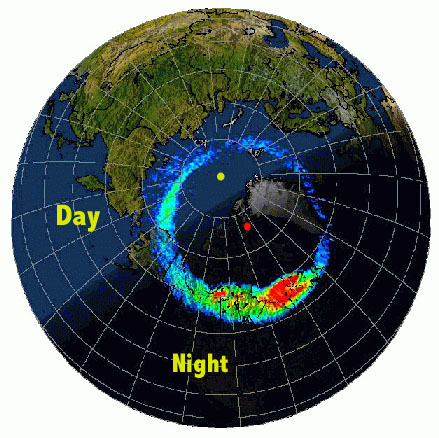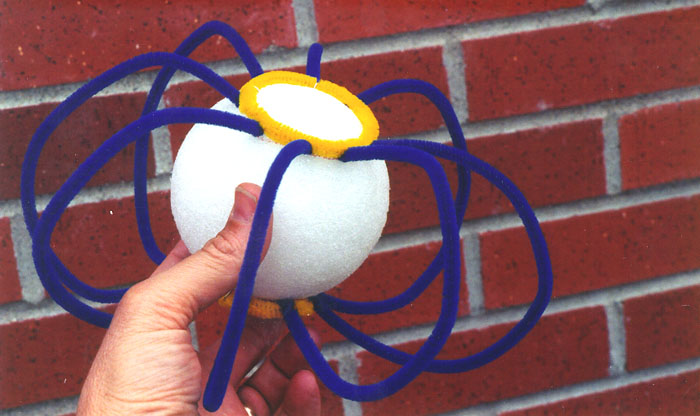|
Image courtesy of Visible Imaging System/Polar, University of Iowa
 This week's picture is a computer-enhanced view of the northern lights (Aurora Borealis) from space. The image was taken by the Polar satellite on September 22, 1996. The yellow dot represents the geographic North Pole and the red dot marks the position of the Magnetic North Pole. On this night the lights may have been visible over Montana. However, they would not have been visible during the daytime due to the brightness of the sun.
This week's picture is a computer-enhanced view of the northern lights (Aurora Borealis) from space. The image was taken by the Polar satellite on September 22, 1996. The yellow dot represents the geographic North Pole and the red dot marks the position of the Magnetic North Pole. On this night the lights may have been visible over Montana. However, they would not have been visible during the daytime due to the brightness of the sun.
Many people think that sunlight reflecting off of ice at the poles causes the northern lights. This is not true! The true cause of the lights is a combination of three factors. . . . the solar wind, Earth’s magnetic field, and the atmosphere.
Watch this 2-minute video of the northern lights over Norway.
The solar wind . . .
The sun is constantly emitting charged particles (electrons and positive ions). This invisible "wind" of particles, called plasma, varies in intensity depending on how active the sun has been. If there is some sort of flare or other type of "storm" on the sun, the solar wind becomes stronger.
Earth's magnetic field . . .
We are protected from the harmful effects of the solar wind by Earth's magnetic field. The magnetism of our planet forms an invisible shield represented by the blue lines (pipe cleaners) on the model below. Notice on the image above that the lines of magnetism form a circle (or oval) centered around the Magnetic North Pole (red dot).
Earth's atmosphere . . .
As the solar wind encounters our magnetic field, the lines guide some of the charged particles down toward the Earth. As the particle enter our atmosphere, something similar to what happens in a fluorescent light bulb takes place. The charged particles "energize" gases in the atmosphere, causing them to emit light. The normal position of the auroral oval is far to the north of us. The city best positioned to see the light show may be Fairbanks, Alaska. As long as the night is dark and clear, there is a very good chance that residents of central Alaska will see the lights. A similar ring of light exists near the Magnetic South Pole (the southern lights; Aurora Australis).
So what does it take for us to see the lights in Montana? . . .
In order for the oval to be present over the Big Sky state, there must be some sort of storm on the sun. If such a storm causes a burst of solar wind (coronal mass ejection) this can disrupt Earth's magnetic field, causing those invisible lines of magnetism (blue lines on model) to enter the Earth much farther to the south of their normal position. This happens more often during a "solar maximum": a year when the sun is especially active. The last solar max occurred in 2001 and the next is expected in fall of 2013. The Solar Max is Coming!
Below: This model, made with a styrofoam sphere and pipe cleaners, shows the relationship between the magnetic field (blue lines) and the auroral oval (yellow ring).

| 







